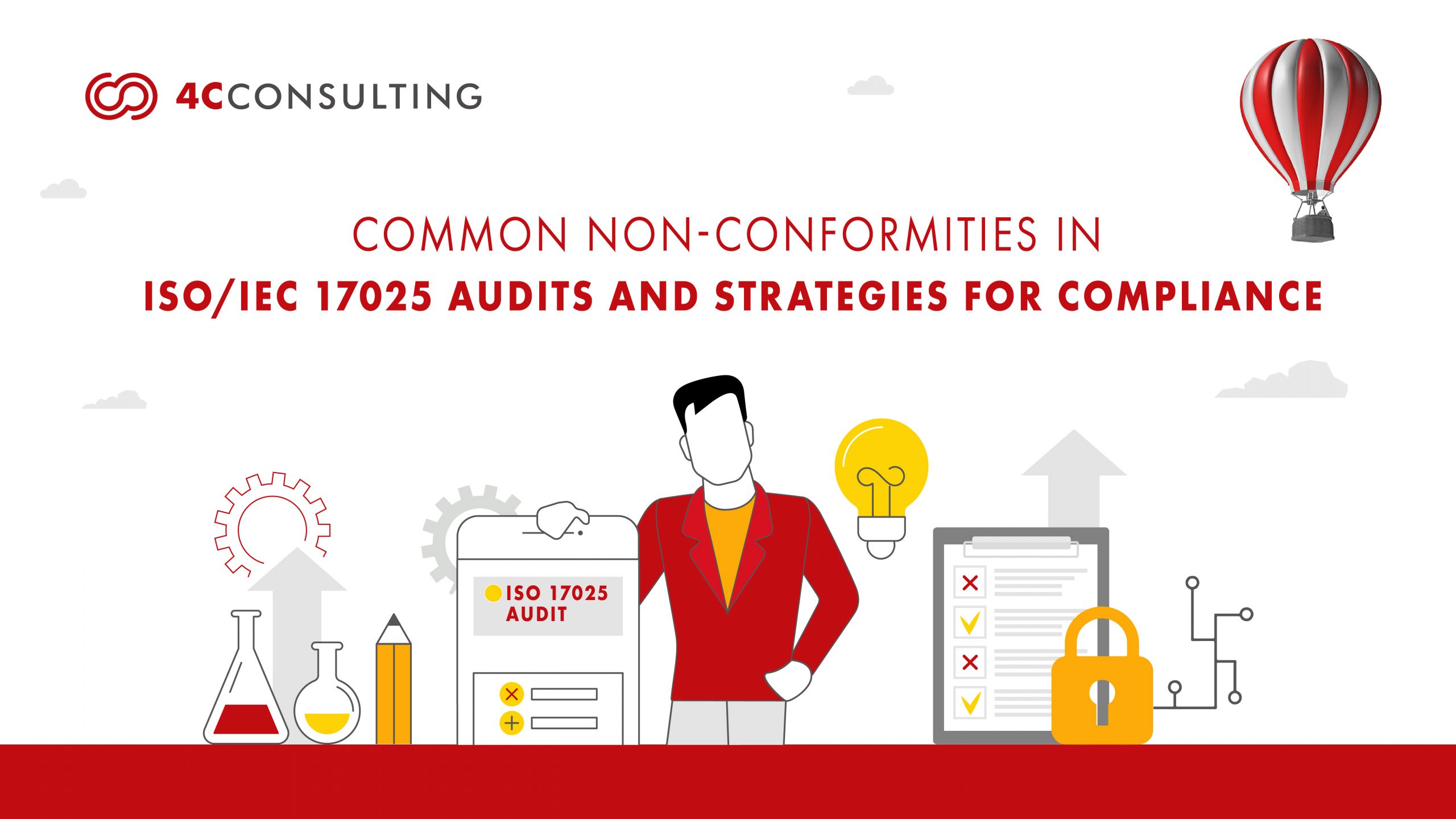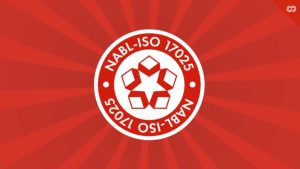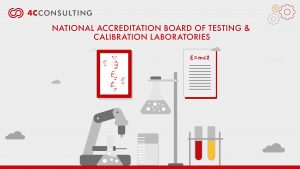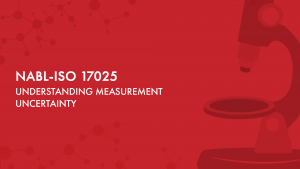COMMON NON-CONFORMITIES IN ISO/IEC 17025 AUDITS AND STRATEGIES FOR COMPLIANCE
19th Sep, 2025Testing and calibration laboratories play a critical role in industries such as pharmaceuticals, automotive, aerospace, power and food safety. For these organizations, NABL accreditation is more than a certificate it demonstrates technical competence, impartiality and reliability of test and calibration results.
Many laboratories face ISO 17025 audit non-conformities during assessments. These often include incomplete documentation, outdated calibration records, insufficient evidence of staff competence or weak ISO 17025 internal audits. In some cases, laboratories treat this certification as a paperwork requirement rather than a living management system, resulting in recurring compliance issues and failed outcomes.
Every non-conformity has consequences. It can undermine credibility, weaken customer trust and even jeopardize contracts with regulators, certification bodies or global clients. By understanding the common non-conformities in ISO 17025 and adopting corrective measures, laboratories can reduce risks, improve audit readiness and achieve accreditation with greater confidence.
This blog highlights frequent ISO/IEC 17025 compliance issues, explains why such audit findings occur and shares practical strategies to overcome these audit challenges.
.
WHAT IS ISO/IEC 17025?
ISO/IEC 17025 is the internationally recognized standard for testing and calibration laboratories. It specifies the general requirements for competence, impartiality and consistent operations, ensuring that laboratory results are valid, traceable and globally accepted.
Unlike ISO 9001, which focuses on quality management at an organizational level, ISO/IEC 17025 goes deeper into the technical requirements that directly influence laboratory outcomes. These include method validation, equipment calibration, staff competency, risk management and data integrity all of which are evaluated during ISO 17025 audits.
.
Overcome Common ISO/IEC 17025 Non-Conformities.
For organizations, achieving ISO/IEC 17025 accreditation brings several advantages:
- Recognition of technical competence by regulators, accreditation bodies and customers worldwide.
- Greater reliability of test and calibration results, minimizing disputes, re-testing and costly compliance failures.
- Support for regulatory compliance across critical industries such as pharma, food, environment and manufacturing.
- Enhanced customer confidence and market competitiveness both domestically and internationally.
ISO/IEC 17025 framework provides a structured compliance framework that helps laboratories reduce ISO 17025 audit non-conformities and operate with transparency, accuracy and credibility. This is why ISO/IEC 17025 compliance issues are taken so seriously they directly reflect whether a lab is audit-ready and able to meet global expectations.
.
Key Reasons to Implement ISO/IEC 17025
Organizations Implement ISO/IEC 17025 not only for recognition but also in response to increasing industry pressures, regulatory requirements and client expectations. The key drivers for implementation include:
- Integration with Global Supply Chains: As supply chains become increasingly international, only results from accredited laboratories are widely accepted. Implementation of ISO/IEC 17025 ensures laboratory outputs are recognized across border enabling global market participation.
- Commitment to Impartiality and Integrity: Beyond technical competence, laboratories must demonstrate impartiality and transparency. ISO/IEC 17025 introduces safeguards to prevent conflicts of interest and reinforce trust in laboratory practices.
- Customer and Stakeholder Demands: Global clients, regulators and certification bodies increasingly expect laboratories to operate in line with ISO/IEC 17025 standards. Accreditation often becomes a mandatory requirement for contracts, approvals and long-term partnerships.
- Consistency Across Operations: In the absence of a standardized framework, laboratories often struggle with variations in methods, record-keeping and reporting. This certification introduces a unified system that ensures results remain consistent, regardless of personnel changes or equipment variations.
- Mitigation of Non-Compliance Risks: Unplanned equipment failures, inadequate staff training or poor documentation can disrupt laboratory operations and create compliance gaps. Implementing ISO 17025 establishes structured processes to minimize these risks before they result in major non-conformities.
- Competitive Advantage: In highly regulated industries such as pharmaceuticals, food and aerospace organizations prefer working with accredited laboratories. Without NABL ISO 17025 laboratories risk losing business opportunities to competitors that demonstrate stronger compliance and reliability.
By adopting ISO 17025 certification standards laboratories move beyond basic compliance to build a robust framework for quality assurance, risk management and sustainable market leadership.
.
COMMON NON-CONFORMITIES IN ISO/IEC 17025 AUDIT AND THEIR FINDINGS
| COMMON NON-CONFORMITIES IN ISO/IEC 17025 AUDIT AND THEIR FINDINGS |
| ISO 17025 CLAUSE NO. | NON-CONFORMITY (NC) | AUDIT FINDINGS |
| Personnel (Clause 6.2) | Competence Not Demonstrated | Technical staff are not evaluated for competence, ISO 17025 training records incomplete and no evidence of periodic skill assessment. |
| Equipment (Clause 6.4) | Calibration and Equipment Gaps | Equipment used without valid calibration certificates, no traceability to national/international standards or preventive maintenance records incomplete. |
| Purchasing & External Services (Clause 6.6) | Supplier and External Provider Weakness | No evaluation records for external calibration providers, lack of evidence that subcontracted services meet ISO/IEC 17025 requirements. |
| Sample Management (Clause 7.4) | Sample Handling & Traceability Gaps | Incomplete sample labelling, chain-of-custody not recorded, poor storage practices and traceability from receipt to reporting not demonstrated. |
| Records & Data (Clause 7.5 / 7.11) | Improper Handling of Data and Results | Raw data not archived, reliance on uncontrolled spreadsheets and inadequate data validation or access control. |
| Methods (Clause 7.2) / Measurement Uncertainty (Clause 7.6) | Method Validation & MU Weakness | Test methods used without validation, uncertainty evaluations missing or inadequately documented, justification for method selection are not recorded. |
| Complaints & Corrective Actions (Clause 7.9 / 8.7) | Poor Complaint Handling & CAPA | Customer complaints not formally recorded, corrective actions delayed or ineffective or repeat NCs observed across audits. |
| Document Control (Clause 8.3) | Incomplete / Uncontrolled Documentation | Quality Manual, SOPs and test methods not updated. Document version control absent or uncontrolled copies in circulation. |
| Risk & Impartiality (Clause 8.5 / 4.1) | Weak Risk Management & Impartiality Oversight | No risk register maintained, impartiality threats (e.g., conflict of interest) not documented & preventive actions missing. |
| Internal Audit (Clause 8.8) / Management Review (Clause 8.9) | Deficient Internal Audits and Reviews | Internal audits not conducted as per schedule, findings not closed, management reviews missing inputs such as risk or impartiality and customer feedback. |
.
STRATEGIES TO ADDRESS NON-CONFORMITIES IN ISO 17025 STANDARDS
- Competence Not Demonstrated: Auditors frequently raise NCs when staff training records are incomplete or when competence evaluations are missing. For instance, in a audit of a pharma laboratory technicians operating GC instruments could not provide evidence of method-specific training. The NC was closed only after the lab implemented a competence matrix, linked ISO 17025 training to each analytical method and documented periodic performance checks. This ensured auditors could trace skills directly to responsibilities.
- Calibration and Equipment Gaps: This common finding is of instruments without valid calibration. In one automotive calibration lab torque wrenches were in active use despite expired calibration certificates making all results for that period unreliable. The lab corrected the NC by introducing a master calibration calendar with automated alerts and by tagging equipment to prevent use when certificates lapse. This practice now ensures audit readiness at all times.
- Supplier and External Provider Weakness: Many labs outsource calibration or testing without verifying the supplier’s accreditation. In a food testing lab, a subcontracted microbiology test provider was found to be non-accredited leading to rejection of outsourced reports. By creating a supplier evaluation checklist (including NABL/ISO 17025 scope review) the lab established evidence-based approval of external providers preventing recurrence of this NC.
- Sample Handling & Traceability Gaps: One materials testing lab was cited for poor sample traceability when auditors found multiple samples stored without unique identifiers. This created uncertainty about which results belonged to which client. The corrective action involved implementing barcode labelling, logging samples into a chain-of-custody register and defining storage protocols. This system not only satisfied auditors but also reduced internal mix-ups.
- Improper Handling of Data and Results: Data integrity issues are a major NC. In an environmental testing lab, auditors flagged uncontrolled Excel files used for recording water quality parameters formulas could be edited without authorization. The lab addressed this by migrating to a validated Laboratory Information Management System (LIMS), locking historical records and introducing access controls. This not only resolved the NC but strengthened client trust in data reliability.
- Method Validation & MU Weakness: Auditors often find that methods are applied without documented validation. In one pathology lab, a new PCR test was introduced without validation or uncertainty estimation. The NC was closed after the lab developed a validation protocol aligned with ISO/IEC 17025, performed inter laboratory comparisons and prepared a documented uncertainty budget. This gave confidence in method reliability during surveillance audits.
- Poor Complaint Handling & CAPA: A calibration lab received multiple client complaints about delayed reports but had no formal complaint log. During audit this was flagged as a repeat NC. The lab established a complaint register, linked it to CAPA workflows and reviewed trends in management meetings. Within 6 months, complaint closure times improved, demonstrating continual improvement to auditors.
- Incomplete / Uncontrolled Documentation: Document control is one of the most common NCs. In a power sector testing lab, auditors discovered technicians using outdated SOPs that conflicted with the current Quality Manual. The NC was closed after the lab implemented electronic document control with restricted access, version tracking and quarterly document reviews. This gave auditors confidence that only approved documents were in use.
- Weak Risk Management & Impartiality Oversight: In a recent audit, a laboratory director was found to be both managing client relations and approving test results for the same client a clear impartiality risk. The NC was resolved by introducing impartiality declarations, maintaining a risk register and assigning result approvals to independent technical staff. This demonstrated transparent governance to auditors.
- Deficient ISO 17025 Internal Audits and Reviews: One food testing lab had skipped internal audits for two consecutive years, resulting in multiple hidden NCs being discovered during external assessment. Corrective action included preparing an annual audit calendar ISO 17025 internal auditors training and ensuring management reviews addressed risks, customer feedback and audit outcomes. Subsequent audits showed significantly fewer NCs
.
BENEFITS OF IMPLEMENTATION ISO/IEC 17025 CERTIFICATION
- Holistic Quality Culture: Implementing ISO/IEC 17025 goes beyond technical compliance; it fosters a culture where quality is everyone’s responsibility. Staff at all levels become aligned with principles of accuracy, impartiality and transparency. This shift ensures that good practices are consistently applied, not just during audits. Over time, laboratories build an environment where excellence is embedded in day-to-day operations.
- Transparent Decision-Making: Reliable decisions depend on validated data, documented competence and controlled processes all central to ISO/IEC 17025. With evidence-based insights, management can make confident choices about methods resources and investments. This transparency also provides clarity for regulators and clients reviewing the lab’s operations. The result is stronger governance backed by traceable, defensible records.
- Strengthened Global Credibility: Accreditation under ISO/IEC 17025 signals international recognition of competence. Test reports and calibration certificates gain acceptance across borders without the need for revalidation. This credibility facilitates easier entry into global supply chains and collaborations with multinational clients. It positions laboratories as trusted world-class service providers.
- Streamlined Collaboration: Implementation brings structure to how teams share data, manage samples and communicate findings. Standardized documentation and reporting reduce misunderstandings and delays in multi-disciplinary projects. External stakeholders such as suppliers or clients also benefit from this consistency. As a result, collaboration becomes smoother and more productive strengthening professional partnerships.
- Future-Ready Operations: ISO/IEC 17025 promotes continual improvement and adaptation to change. Laboratories are encouraged to adopt digital tools such as LIMS, align with evolving industry standards and anticipate regulatory shifts. This future oriented approach ensures the lab remains competitive and compliant in dynamic industries. Instead of reacting to changes the organization stays prepared for them.
- Talent Retention and Attraction: Professionals value working in structured environments where competence is recognized and career growth is supported. ISO/IEC 17025 provides clear role definitions, training pathways and performance evaluations. This clarity helps retain skilled staff while also attracting new talent seeking stability and growth opportunities. Over time, the lab benefits from a motivated and capable workforce.
- Reputation for Reliability: Consistent implementation of ISO/IEC 17025 builds a reputation that extends beyond certification. Clients, regulators and partners begin to associate the laboratory with reliability and technical excellence. This reputation becomes a powerful differentiator in competitive markets, where credibility often drives contract decisions. Long-term, it reinforces the lab’s position as a preferred and trusted partner.
.
ISO/IEC 17025 is not just about passing an audit; it is about building a laboratory culture rooted in accuracy, impartiality and continual improvement. While common non-conformities such as incomplete documentation, calibration gaps, weak internal audits or data integrity issues can delay accreditation, addressing them with structured strategies strengthens both compliance and credibility. By effectively implementing ISO/IEC 17025 laboratories can reduce risks, enhance customer trust and position themselves as reliable, globally recognized partners in highly regulated industries.
.
HOW 4C CONSULTING HELPS YOU IMPLEMENT ISO/IEC 17025 IN YOUR ORGANIZATION?
At 4C Consulting, we bring 20+ years of expertise in testing and calibration environments to simplify ISO/IEC 17025 implementation. 10,000+ training hours and 50+ workshops into a structured end-to-end approach covers gap assessments, documentation support, competence management, equipment calibration schedules, risk registers, training and internal audits all tailored to your laboratory’s needs. By identifying potential non-conformities early and integrating best practices into daily operations, we ensure your systems are audit-ready, reliable and aligned with global expectations. Partnering with 4C means smoother NABL accreditation stronger client trust and long-term operational excellence. Book your Free ISO/IEC 17025 Gap Assessment today.

Frequently Asked Questions:
NC stands for Non-Conformance in an ISO audit. It refers to a situation where a process, practice, or record does not meet the requirements of the ISO standard or the organization’s own procedures. NCs can be major (serious gaps that affect compliance) or minor (smaller deviations that still need correction). Identifying NCs helps organizations improve their systems and achieve full compliance.
The five core requirements of ISO/IEC 17025 are:
1. Impartiality and confidentiality: ensuring unbiased testing and protecting client data.
2. Structural requirements: defining roles, responsibilities and management systems.
3. Resource requirements: covering personnel competence, equipment and facilities.
4. Process requirements: how testing and calibration activities are performed.
5. Management system requirements: maintaining continual improvement and documentation control.
These requirements ensure laboratories deliver reliable, valid and internationally accepted results.
A common example of non-conformance in a laboratory is using equipment past its calibration due date. For instance, if a balance or pH meter is not calibrated as scheduled but is still used for testing, the results cannot be trusted. Other examples include incomplete test records, untrained staff performing tests, or missing environmental monitoring logs.
Clause 4.1 of ISO/IEC 17025 relates to Impartiality. It requires laboratories to conduct activities in a way that is free from internal or external pressures that may compromise the integrity of results. Labs must identify risks to impartiality, manage them and ensure staff act objectively at all times.
Clause 6.4 covers Equipment. It ensures laboratories use equipment that is suitable, properly maintained and calibrated to perform valid testing and calibration. This includes equipment selection, installation, calibration intervals, maintenance records and ensuring equipment is not used outside its intended scope.
Clause 7.4 refers to Review of Requests, Tenders and Contracts. Laboratories must ensure they fully understand customer requirements before accepting work. This includes technical capacity, appropriate methods, resources and client communication. Proper review prevents misunderstandings and guarantees results meet agreed standards.
Clause 5 addresses Structural Requirements. It specifies that the laboratory must be a legally identifiable entity, define responsibilities clearly and ensure management has the authority to make decisions. This structure ensures accountability, consistency and alignment with ISO 17025’s quality and technical requirements.






